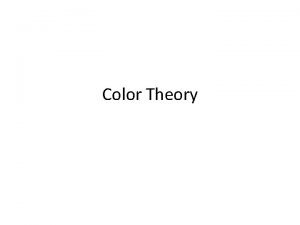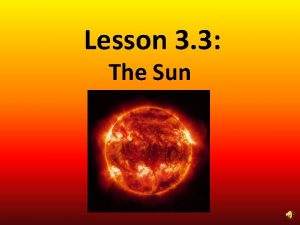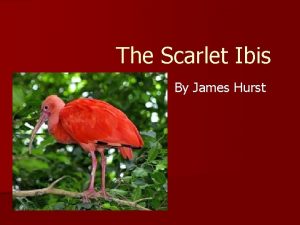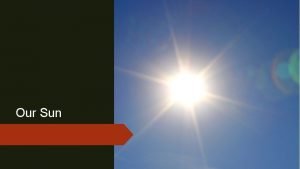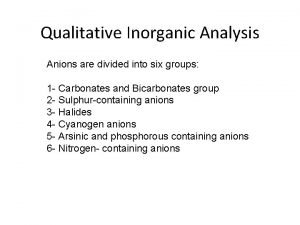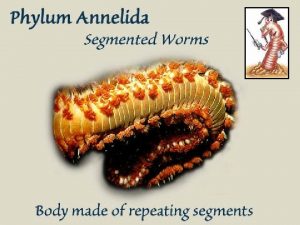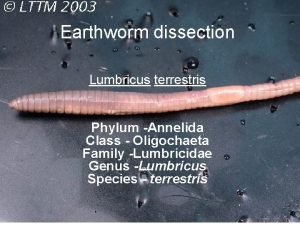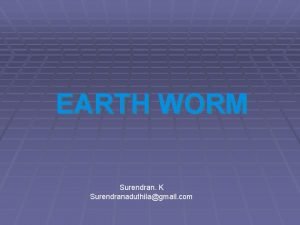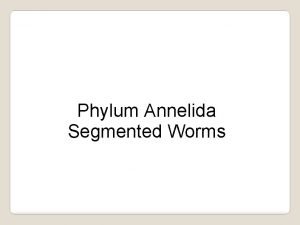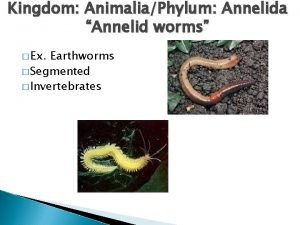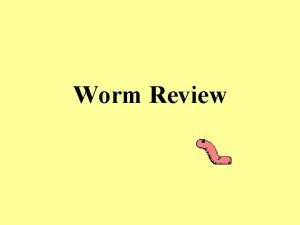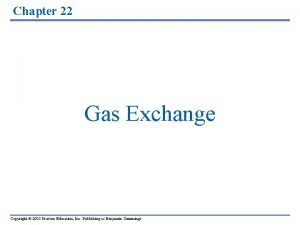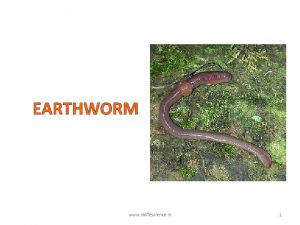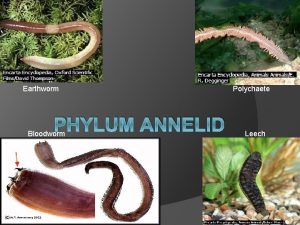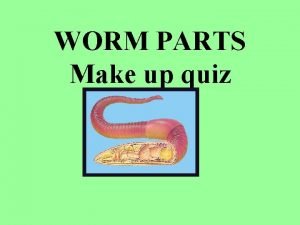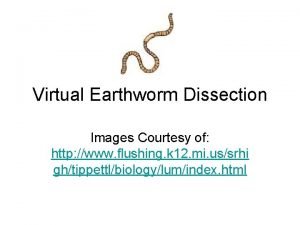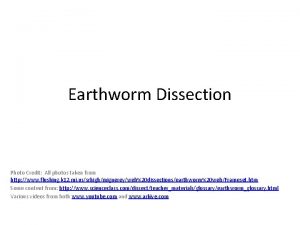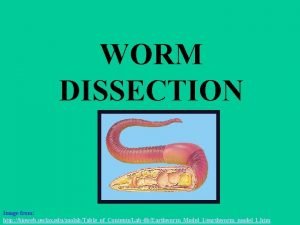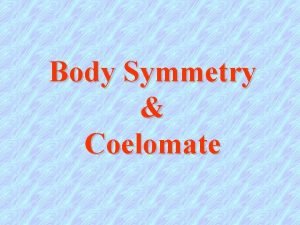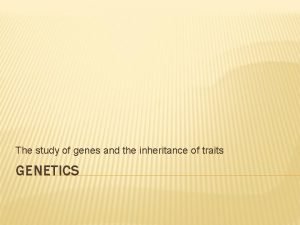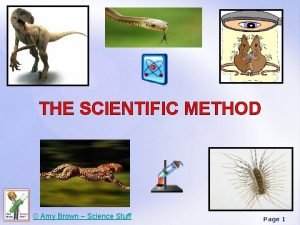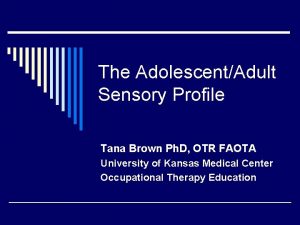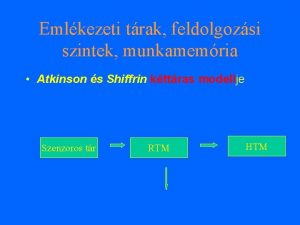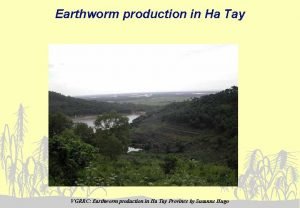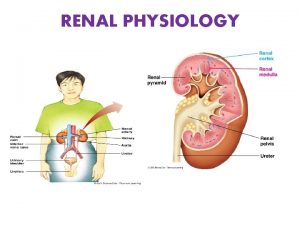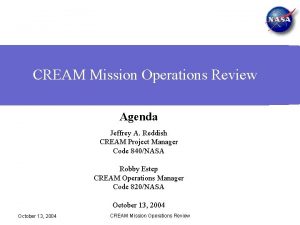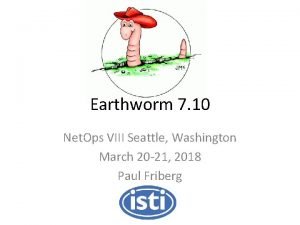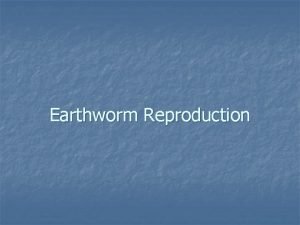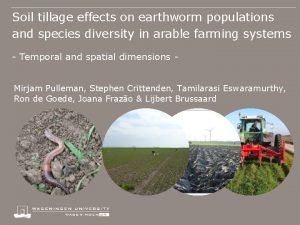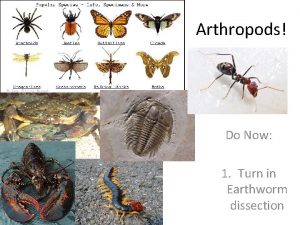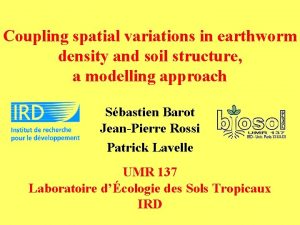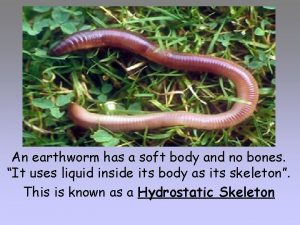EARTHWORM www sblifescience in 1 EARTHWORM Reddish brown

EARTHWORM www. sblifescience. in 1

EARTHWORM • Reddish brown terrestrial invertebrate • Inhabits the upper layer of the moist soil. • During day time, they live in burrows made by boring and swallowing the soil. www. sblifescience. in 2

EARTHWORM • The common Indian earthworms are Pheretima and Lumbricus. www. sblifescience. in 3

MORPHOLOGY www. sblifescience. in 4

EARTHWORM • Long cylindrical body. • The body is divided into more than hundred short segments which are similar (metameres about 100 -120 in number). www. sblifescience. in 5

EARTHWORM • The dorsal surface of the body is marked by a dark median mid dorsal line (dorsal blood vessel) along the longitudinal axis of the body. • The ventral surface is distinguished by the presence of genital openings (pores). www. sblifescience. in 6

EARTHWORM www. sblifescience. in 7

PROSTOMIUM • Anterior end consists of the mouth and the prostomium. • Prostomium is a lobe which serves as a covering for the mouth and as a wedge to force open cracks in the soil into which the earthworm may crawl. • The prostomium is sensory in function www. sblifescience. in 8

PERISTOMIUM • The first body segment is called the peristomium (buccal segment) which contains the mouth. www. sblifescience. in 9

CLITELLUM • In a mature worm, segments 14 -16 are covered by a prominent dark band of glandular tissue called clitellum. • Body is divisible into three prominent regions – preclitellar, clitellar and postclitellar segments www. sblifescience. in 10

SPERMATHECAL APERTURES • Four pairs of spermathecal apertures are situated on the ventro-lateral sides of the intersegmental grooves, i. e. , 5 th -9 th segments. • A single female genital pore is present in the mid-ventral line of 14 th segment. www. sblifescience. in 11

MALE GENITAL PORES • A pair of male genital pores are present on the ventro-lateral sides of the 18 th segment. • Numerous minute pores called nephridiopores open on the surface of the body. 14 18 www. sblifescience. in 12

SETAE • In each body segment, except the first, last and clitellum, there are rows of S-shaped setae, embedded in the epidermal pits in the middle of each segment. • Setae can be extended or retracted. • Principal role is in locomotion. www. sblifescience. in 13

ANATOMY www. sblifescience. in 14

BODY WALL • Thin non-cellular cuticle (outer). • Epidermis (Made up of a single layer of columnar epithelial cells which contain secretory gland cells. ) • Two muscle layers (circular and longitudinal) • Coelomic epithelium (innermost). www. sblifescience. in 15

DIGESTIVE SYSTEM • The alimentary canal is a straight tube and runs between first to last segment of the body. www. sblifescience. in 16

DIGESTIVE SYSTEM • Mouth(1 st segment) • Buccal cavity (1 -3 segments) • Muscular pharynx. (4 th segment) • Oesophagus (5 -7 s), • Muscular gizzard (8 -9 segments). • The stomach (9 -14 segments). • Intestine (15 th segment to last segment) • Anus (last segment) www. sblifescience. in 17

DIGESTIVE SYSTEM • The food of the earthworm is decaying leaves and organic matter mixed with soil. • Gizzard helps in grinding the soil particles and decaying leaves, etc. www. sblifescience. in 18

DIGESTIVE SYSTEM • Calciferous glands, present in the stomach, neutralise the humic acid present in humus. www. sblifescience. in 19

DIGESTIVE SYSTEM • A pair of short and conical intestinal caecae project from the intestine on the 26 th segment. • The characteristic feature of the intestine between 26 -35 segments is the presence of internal median fold of dorsal wall called Typhlosole. • Typhlosole increases the effective area of absorption in the intestine. www. sblifescience. in 20

DIGESTIVE SYSTEM • The ingested organic rich soil passes through the digestive tract where digestive enzymes breakdown complex food into smaller absorbable units. These simpler molecules are absorbed through intestinal membranes and are utilised www. sblifescience. in 21

CIRCULATORY SYSTEM • Closed type of blood vascular system (blood is confined to the heart and blood vessels) • Blood vessels, • Capillaries • Heart. • Smaller blood vessels supply the gut, nerve cord, and the body wall. www. sblifescience. in 22

CIRCULATORY SYSTEM • Blood glands are present on the 4 th, 5 th and 6 th segments. • Blood glands produce blood cells and haemoglobin which is dissolved in blood plasma. • Blood cells are phagocytic in nature. www. sblifescience. in 23

RESPIRATORY SYSTEM • Earthworms lack specialised breathing devices. • Respiratory exchange occurs through moist body surface into their blood stream. www. sblifescience. in O 2 CO 2 24

EXCRETORY SYSTEM • The excretory organs occur as segmentally arranged coiled tubules called Nephridia (sing. : nephridium). • They are of three types: • (i) Septal nephridia • (ii) Integumentary nephridia • (iii) Pharyngeal nephridia, www. sblifescience. in 25

EXCRETORY SYSTEM • Septal nephridia – Present on both the sides of intersegmental septa of segment 15 to the last that open into intestine. • Integumentary nephridia, – Attached to lining of the body wall of segment 3 to the last that open on the body surface. • Pharyngeal nephridia, – Present as three paired tufts in the 4 th, 5 th and 6 th segments www. sblifescience. in 26

EXCRETORY SYSTEM • Different types of nephridia are basically similar in structure. • Nephridia regulate the volume and composition of the body fluids. • A nephridium starts out as a funnel that collects excess fluid from coelomic chamber. The funnel connects with a tubular part of the nephridium which delivers the wastes through a pore to the surface in the body wall or into the digestive tube. www. sblifescience. in 27

EARTHWORM ANATOMY www. sblifescience. in 28

NERVOUS SYSTEM • Represented by ganglia • Arranged segment wise on the ventral paired nerve cord. • The nerve cord in the anterior region (3 rd and 4 th segments) bifurcates, laterally encircling the pharynx and joins the cerebral ganglia dorsally to form a nerve ring. www. sblifescience. in 29

NERVOUS SYSTEM • The cerebral ganglia along with other nerves in the ring integrate sensory input as well as command muscular responses of the body. www. sblifescience. in 30

SENSORY SYSTEM • No eyes • But possess light and touch sensitive organs (receptor cells) to distinguish the light intensities and to feel the vibrations in the ground. • Worms have specialised chemoreceptors (taste receptors) which react to chemical stimuli. • These sense organs are located on the anterior part of the worm. www. sblifescience. in 31

REPRODUCTIVE SYSTEM • Earthworm is hermaphrodite (bisexual), i. e. , testes and ovaries are present in the same individual. www. sblifescience. in 32

REPRODUCTIVE SYSTEM • Two pairs of testes present in the 10 th and 11 th segments. • Vasa deferentia run up to the 18 th segment where they join the prostatic duct. • Two pairs of accessory glands are present one pair each in the 17 th and 19 th segments. • The common prostrate and spermatic duct opens to the exterior by a pair of male genital pores on the ventrolateral side of the 18 th segment. www. sblifescience. in 33

REPRODUCTIVE SYSTEM • Four pairs of spermathecae are located in 6 th-9 th segments (one pair in each segment). • They receive and store spermatozoa during copulation. www. sblifescience. in 34

REPRODUCTIVE SYSTEM • One pair of ovaries is attached at the intersegmental septum of the 12 th and 13 th segments. • Ovarian funnels are present beneath the ovaries which continue into oviduct, join together and open on the ventral side as a single median female genital pore on the 14 th segment. www. sblifescience. in 35

REPRODUCTIVE SYSTEM • A mutual exchange of sperm occurs between two worms during mating. • One worm has to find another worm and they mate juxtaposing opposite gonadal openings exchanging packets of sperms called spermatophores. www. sblifescience. in 36
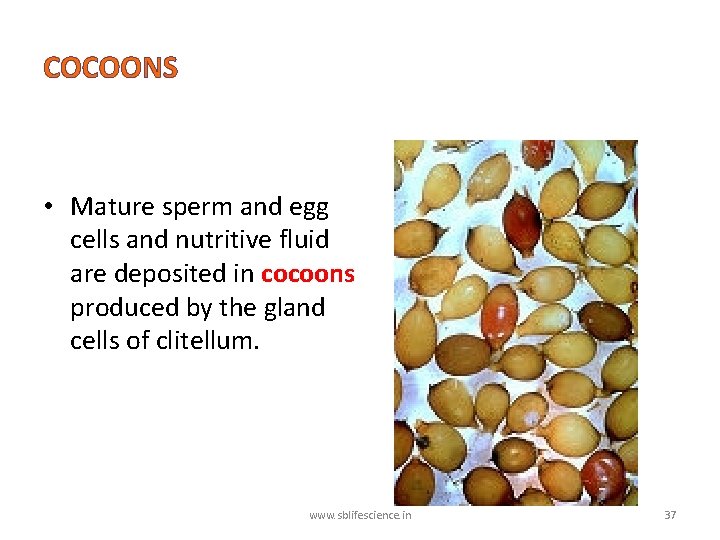
COCOONS • Mature sperm and egg cells and nutritive fluid are deposited in cocoons produced by the gland cells of clitellum. www. sblifescience. in 37

FERTILISATION • Fertilisation and development occur within the cocoons which are deposited in soil. • The ova (eggs) are fertilised by the sperm cells within the cocoon which then slips off the worm and is deposited in or on the soil. www. sblifescience. in 38

DEVELOPMENT • The cocoon holds the worm embryos. • After about 3 weeks, each cocoon produces two to twenty baby worms with an average of four. • Earthworms development is direct, i. e. , there is no larva formed. www. sblifescience. in 39

ECONOMIC IMPORTANCE • Earthworms are known as ‘friends of farmers’ because they make burrows in the soil and make it porous which helps in respiration and penetration of the developing plant roots. www. sblifescience. in 40
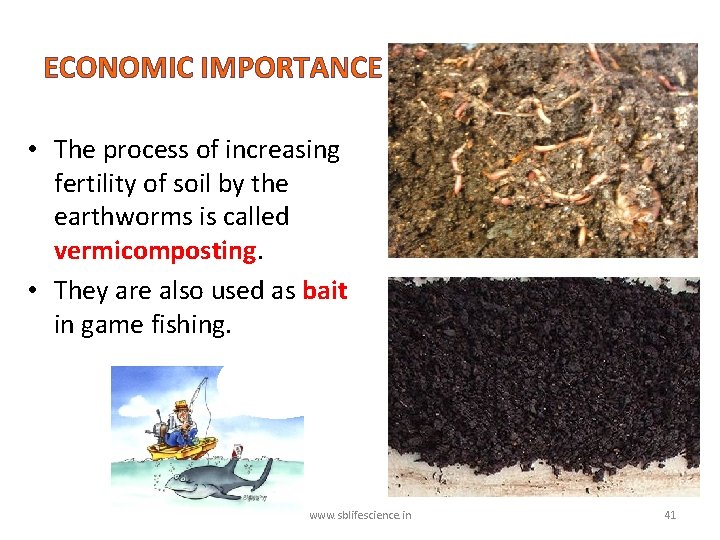
ECONOMIC IMPORTANCE • The process of increasing fertility of soil by the earthworms is called vermicomposting. • They are also used as bait in game fishing. www. sblifescience. in 41
- Slides: 41

